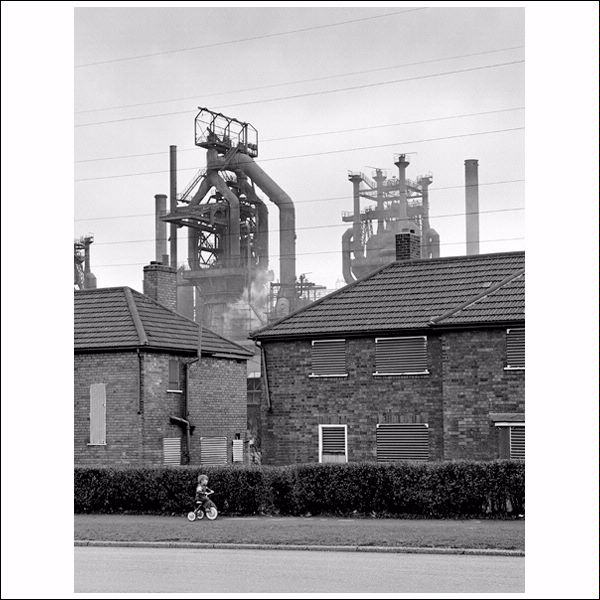Small boy on bike, Steelworks, Corby
Small boy on bike
Corby Steel Works.
The Steelworks circa 1972.
Corby has always been known as an iron-working region, even before the arrival of the Romans and their ironworks and the Doomsday Book names the 'Manor of Corbei' as an iron-producing centre.
With the arrival of rail in the 19th century iron working really took off. It was in the 1930's that construction of what was to become one of the largest steelworks in Britain commenced.
Corby had its own ironstone works in 1910, the plant being taken over by Stewarts and Lloyds in 1920. It was not, however, until 1933 that construction began to tap the vast reserves under the surface of the surrounding countryside to produce steel, and to manufacture tubes for the world's markets.
Corby became a centre of frantic activity and people flooded from all over Britain to the town for employment. The first of the Scots arriving around 1934 to form a large proportion of the new population and who still have a considerable influence on the culture of the Borough today.
During World War II, the skills of Corby workers made a significant contribution to the invasion of Europe, by developing the pipeline under the ocean (PLUTO), a cross-channel link, carrying essential fuel to the Allied forces to support the Allied forces after the D Day invasion.
In 1980, British Steel decided to close the steel works and the effect was devastating on Corby with 6,000 people being made redundant. Massive lobbying of Westminster and Europe by Councillors and residents ensured that Corby did not die. The decision was made to pull the old works down as quickly as possible to show the commitment to redevelopment. Within 15 months of the closure, 15,000 new jobs were created by 1,500 new businesses occupying 1.5 million square feet of new business units.
Small boy on bike, Steelworks, Corby
Small boy on bike
Corby Steel Works.
The Steelworks circa 1972.
Corby has always been known as an iron-working region, even before the arrival of the Romans and their ironworks and the Doomsday Book names the 'Manor of Corbei' as an iron-producing centre.
With the arrival of rail in the 19th century iron working really took off. It was in the 1930's that construction of what was to become one of the largest steelworks in Britain commenced.
Corby had its own ironstone works in 1910, the plant being taken over by Stewarts and Lloyds in 1920. It was not, however, until 1933 that construction began to tap the vast reserves under the surface of the surrounding countryside to produce steel, and to manufacture tubes for the world's markets.
Corby became a centre of frantic activity and people flooded from all over Britain to the town for employment. The first of the Scots arriving around 1934 to form a large proportion of the new population and who still have a considerable influence on the culture of the Borough today.
During World War II, the skills of Corby workers made a significant contribution to the invasion of Europe, by developing the pipeline under the ocean (PLUTO), a cross-channel link, carrying essential fuel to the Allied forces to support the Allied forces after the D Day invasion.
In 1980, British Steel decided to close the steel works and the effect was devastating on Corby with 6,000 people being made redundant. Massive lobbying of Westminster and Europe by Councillors and residents ensured that Corby did not die. The decision was made to pull the old works down as quickly as possible to show the commitment to redevelopment. Within 15 months of the closure, 15,000 new jobs were created by 1,500 new businesses occupying 1.5 million square feet of new business units.

Small boy on bike, Steelworks, Corby
Small boy on bike
Corby Steel Works.
The Steelworks circa 1972.
Corby has always been known as an iron-working region, even before the arrival of the Romans and their ironworks and the Doomsday Book names the 'Manor of Corbei' as an iron-producing centre.
With the arrival of rail in the 19th century iron working really took off. It was in the 1930's that construction of what was to become one of the largest steelworks in Britain commenced.
Corby had its own ironstone works in 1910, the plant being taken over by Stewarts and Lloyds in 1920. It was not, however, until 1933 that construction began to tap the vast reserves under the surface of the surrounding countryside to produce steel, and to manufacture tubes for the world's markets.
Corby became a centre of frantic activity and people flooded from all over Britain to the town for employment. The first of the Scots arriving around 1934 to form a large proportion of the new population and who still have a considerable influence on the culture of the Borough today.
During World War II, the skills of Corby workers made a significant contribution to the invasion of Europe, by developing the pipeline under the ocean (PLUTO), a cross-channel link, carrying essential fuel to the Allied forces to support the Allied forces after the D Day invasion.
In 1980, British Steel decided to close the steel works and the effect was devastating on Corby with 6,000 people being made redundant. Massive lobbying of Westminster and Europe by Councillors and residents ensured that Corby did not die. The decision was made to pull the old works down as quickly as possible to show the commitment to redevelopment. Within 15 months of the closure, 15,000 new jobs were created by 1,500 new businesses occupying 1.5 million square feet of new business units.